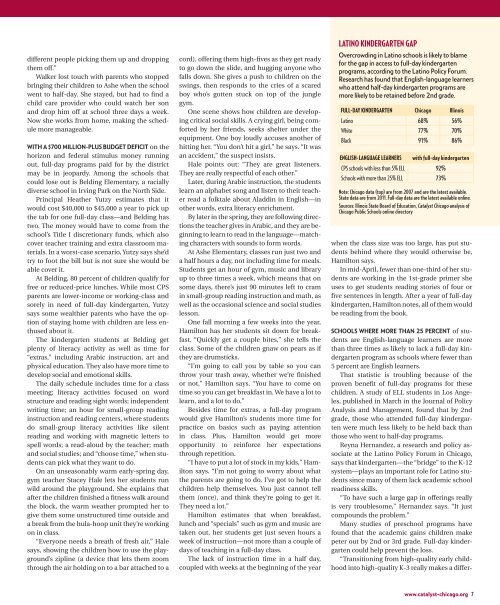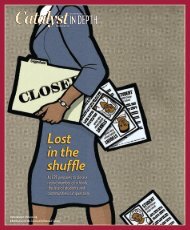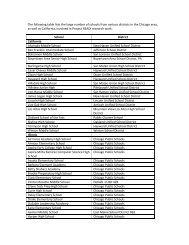The ABCs of kindergarten - catalyst-chicago.org
The ABCs of kindergarten - catalyst-chicago.org
The ABCs of kindergarten - catalyst-chicago.org
You also want an ePaper? Increase the reach of your titles
YUMPU automatically turns print PDFs into web optimized ePapers that Google loves.
different people picking them up and dropping<br />
them <strong>of</strong>f.”<br />
Walker lost touch with parents who stopped<br />
bringing their children to Ashe when the school<br />
went to half-day. She stayed, but had to find a<br />
child care provider who could watch her son<br />
and drop him <strong>of</strong>f at school three days a week.<br />
Now she works from home, making the schedule<br />
more manageable.<br />
With a $700 million-plus budget deficit on the<br />
horizon and federal stimulus money running<br />
out, full-day programs paid for by the district<br />
may be in jeopardy. Among the schools that<br />
could lose out is Belding Elementary, a racially<br />
diverse school in Irving Park on the North Side.<br />
Principal Heather Yutzy estimates that it<br />
would cost $40,000 to $45,000 a year to pick up<br />
the tab for one full-day class—and Belding has<br />
two. <strong>The</strong> money would have to come from the<br />
school’s Title I discretionary funds, which also<br />
cover teacher training and extra classroom materials.<br />
In a worst-case scenario, Yutzy says she’d<br />
try to foot the bill but is not sure she would be<br />
able cover it.<br />
At Belding, 80 percent <strong>of</strong> children qualify for<br />
free or reduced-price lunches. While most CPS<br />
parents are lower-income or working-class and<br />
sorely in need <strong>of</strong> full-day <strong>kindergarten</strong>, Yutzy<br />
says some wealthier parents who have the option<br />
<strong>of</strong> staying home with children are less enthused<br />
about it.<br />
<strong>The</strong> <strong>kindergarten</strong> students at Belding get<br />
plenty <strong>of</strong> literacy activity as well as time for<br />
“extras,” including Arabic instruction, art and<br />
physical education. <strong>The</strong>y also have more time to<br />
develop social and emotional skills.<br />
<strong>The</strong> daily schedule includes time for a class<br />
meeting; literacy activities focused on word<br />
structure and reading sight words; independent<br />
writing time; an hour for small-group reading<br />
instruction and reading centers, where students<br />
do small-group literacy activities like silent<br />
reading and working with magnetic letters to<br />
spell words; a read-aloud by the teacher; math<br />
and social studies; and “choose time,” when students<br />
can pick what they want to do.<br />
On an unseasonably warm early-spring day,<br />
gym teacher Stacey Hale lets her students run<br />
wild around the playground. She explains that<br />
after the children finished a fitness walk around<br />
the block, the warm weather prompted her to<br />
give them some unstructured time outside and<br />
a break from the hula-hoop unit they’re working<br />
on in class.<br />
“Everyone needs a breath <strong>of</strong> fresh air,” Hale<br />
says, showing the children how to use the playground’s<br />
zipline (a device that lets them zoom<br />
through the air holding on to a bar attached to a<br />
cord), <strong>of</strong>fering them high-fives as they get ready<br />
to go down the slide, and hugging anyone who<br />
falls down. She gives a push to children on the<br />
swings, then responds to the cries <strong>of</strong> a scared<br />
boy who’s gotten stuck on top <strong>of</strong> the jungle<br />
gym.<br />
One scene shows how children are developing<br />
critical social skills. A crying girl, being comforted<br />
by her friends, seeks shelter under the<br />
equipment. One boy loudly accuses another <strong>of</strong><br />
hitting her. “You don’t hit a girl,” he says. “It was<br />
an accident,” the suspect insists.<br />
Hale points out: “<strong>The</strong>y are great listeners.<br />
<strong>The</strong>y are really respectful <strong>of</strong> each other.”<br />
Later, during Arabic instruction, the students<br />
learn an alphabet song and listen to their teacher<br />
read a folktale about Aladdin in English—in<br />
other words, extra literacy enrichment.<br />
By later in the spring, they are following directions<br />
the teacher gives in Arabic, and they are beginning<br />
to learn to read in the language—matching<br />
characters with sounds to form words.<br />
At Ashe Elementary, classes run just two and<br />
a half hours a day, not including time for meals.<br />
Students get an hour <strong>of</strong> gym, music and library<br />
up to three times a week, which means that on<br />
some days, there’s just 90 minutes left to cram<br />
in small-group reading instruction and math, as<br />
well as the occasional science and social studies<br />
lesson.<br />
One fall morning a few weeks into the year,<br />
Hamilton has her students sit down for breakfast.<br />
“Quickly get a couple bites,” she tells the<br />
class. Some <strong>of</strong> the children gnaw on pears as if<br />
they are drumsticks.<br />
“I’m going to call you by table so you can<br />
throw your trash away, whether we’re finished<br />
or not,” Hamilton says. “You have to come on<br />
time so you can get breakfast in. We have a lot to<br />
learn, and a lot to do.”<br />
Besides time for extras, a full-day program<br />
would give Hamilton’s students more time for<br />
practice on basics such as paying attention<br />
in class. Plus, Hamilton would get more<br />
opportunity to reinforce her expectations<br />
through repetition.<br />
“I have to put a lot <strong>of</strong> stock in my kids,” Hamilton<br />
says. “I’m not going to worry about what<br />
the parents are going to do. I’ve got to help the<br />
children help themselves. You just cannot tell<br />
them (once), and think they’re going to get it.<br />
<strong>The</strong>y need a lot.”<br />
Hamilton estimates that when breakfast,<br />
lunch and “specials” such as gym and music are<br />
taken out, her students get just seven hours a<br />
week <strong>of</strong> instruction—not more than a couple <strong>of</strong><br />
days <strong>of</strong> teaching in a full-day class.<br />
<strong>The</strong> lack <strong>of</strong> instruction time in a half day,<br />
coupled with weeks at the beginning <strong>of</strong> the year<br />
Latino <strong>kindergarten</strong> gap<br />
Overcrowding in Latino schools is likely to blame<br />
for the gap in access to full-day <strong>kindergarten</strong><br />
programs, according to the Latino Policy Forum.<br />
Research has found that English-language learners<br />
who attend half-day <strong>kindergarten</strong> programs are<br />
more likely to be retained before 2nd grade.<br />
full-day <strong>kindergarten</strong> Chicago Illinois<br />
Latino 68% 56%<br />
White 77% 70%<br />
Black 91% 86%<br />
English-language learners<br />
with full-day <strong>kindergarten</strong><br />
CPS schools with less than 5% ELL 92%<br />
Schools with more than 25% ELL 73%<br />
Note: Chicago data (top) are from 2007 and are the latest available.<br />
State data are from 2011. Full-day data are the latest available online.<br />
Sources: Illinois State Board <strong>of</strong> Education, Catalyst Chicago analysis <strong>of</strong><br />
Chicago Public Schools online directory<br />
when the class size was too large, has put students<br />
behind where they would otherwise be,<br />
Hamilton says.<br />
In mid-April, fewer than one-third <strong>of</strong> her students<br />
are working in the 1st-grade primer she<br />
uses to get students reading stories <strong>of</strong> four or<br />
five sentences in length. After a year <strong>of</strong> full-day<br />
<strong>kindergarten</strong>, Hamilton notes, all <strong>of</strong> them would<br />
be reading from the book.<br />
Schools where more than 25 percent <strong>of</strong> students<br />
are English-language learners are more<br />
than three times as likely to lack a full-day <strong>kindergarten</strong><br />
program as schools where fewer than<br />
5 percent are English learners.<br />
That statistic is troubling because <strong>of</strong> the<br />
proven benefit <strong>of</strong> full-day programs for these<br />
children. A study <strong>of</strong> ELL students in Los Angeles,<br />
published in March in the Journal <strong>of</strong> Policy<br />
Analysis and Management, found that by 2nd<br />
grade, those who attended full-day <strong>kindergarten</strong><br />
were much less likely to be held back than<br />
those who went to half-day programs.<br />
Reyna Hernandez, a research and policy associate<br />
at the Latino Policy Forum in Chicago,<br />
says that <strong>kindergarten</strong>—the “bridge” to the K-12<br />
system—plays an important role for Latino students<br />
since many <strong>of</strong> them lack academic school<br />
readiness skills.<br />
“To have such a large gap in <strong>of</strong>ferings really<br />
is very troublesome,” Hernandez says. “It just<br />
compounds the problem.”<br />
Many studies <strong>of</strong> preschool programs have<br />
found that the academic gains children make<br />
peter out by 2nd or 3rd grade. Full-day <strong>kindergarten</strong><br />
could help prevent the loss.<br />
“Transitioning from high-quality early childhood<br />
into high-quality K-3 really makes a differ-<br />
www.<strong>catalyst</strong>-<strong>chicago</strong>.<strong>org</strong> 7









